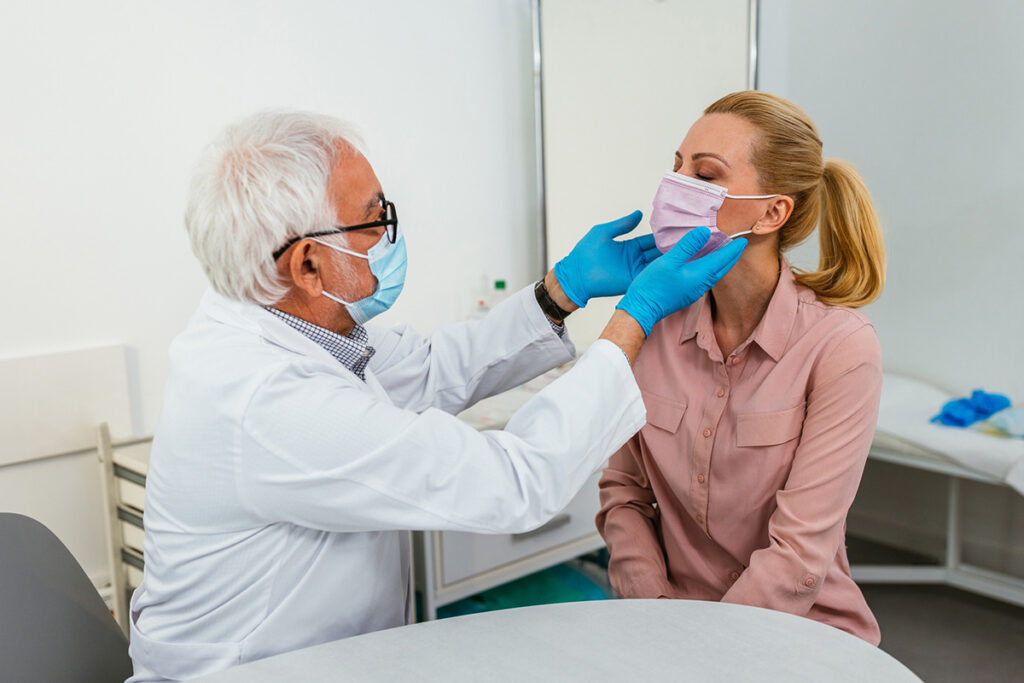What Most People Don’t Know About Thyroid Cancer

Cancer is the second most common cause of death in the U.S. behind heart disease. With 1.9 million new cancer diagnoses happening daily, you, or someone you know, have most likely been affected by one of the more common forms of cancer: breast, colon, or lung.
But you may not know much about thyroid cancer, which is one of the less common but more survivable forms of cancer.
This cancer affects the butterfly-shaped thyroid gland in the front of the neck. It makes hormones that are carried throughout the body to help regulate metabolism, heart rate, blood pressure, and body temperature. So, although it’s small, the thyroid plays a very important role in helping our bodies run correctly.
Types of Thyroid Cancer
According to the National Cancer Institute, 43,800 new thyroid cancer cases will be diagnosed in 2022. (That works out to be 2 percent of all new cancer cases.) There are three types of thyroid cancer: well-differentiated, medullary, and anaplastic.
Well-differentiated thyroid cancers can either be classified as papillary or follicular.
Papillary thyroid cancer makes up about 70 to 80 percent of all thyroid cancer cases. It’s also the most curable type of thyroid cancer.
Follicular thyroid cancer makes up about 10 to 15 percent of thyroid cancer cases. It’s more aggressive than papillary thyroid cancer.
Medullary thyroid cancer makes up about two percent of all thyroid cancer cases and tends to be associated with endocrine tumors that might run in someone’s family.
Anaplastic thyroid cancer is rare, found in about three percent of all thyroid cancer cases, is the most aggressive form, and is the least likely to respond to treatment.
Risk Factors for Thyroid Cancer
Certain risk factors increase a person’s chances of developing thyroid cancer. Having some of these risk factors doesn’t mean you are going to develop thyroid cancer. However, it does mean that you should pay closer attention to any potential symptoms that develop.
Here are some characteristics that can make someone more likely to experience thyroid cancer:
Gender: Women tend to be diagnosed more often, representing three out of every four cases.
Age: About two-thirds of all cases occur in people between the ages of 20 and 55.
Race: White and Asian people are more likely to be diagnosed with thyroid cancer. However, diagnosis is rising in Black and Hispanic populations.
Genetics: A family history of thyroid cancer could be a risk factor. In addition, genetic testing can help determine someone’s risk of developing thyroid cancer.
Radiation exposure: Moderate radiation exposure to the head and neck may increase someone’s risk of experiencing a well-differentiated type of thyroid cancer.
Low iodine diet: Iodine helps the thyroid function properly, so an iodine deficiency may increase cancer risk.
Breast cancer: Survivors of breast cancer who were diagnosed at a younger age have a higher risk of developing thyroid cancer within five years after their breast cancer diagnosis.
Some additional risk factors include an enlarged thyroid and a high body mass index (BMI).
Anyone, regardless of gender, age, or race, can develop thyroid cancer. But understanding these risk factors can help you make smarter decisions about when to see your doctor.
Symptoms of Thyroid Cancer
As a thyroid cancer grows, it may cause some of the following symptoms:
A lump or nodule in the neck that you can feel through your skin
Swelling in your neck and lymph nodes
Pain in your neck and throat
Changes or hoarseness in your voice
Difficulty swallowing or breathing
A cough that persists and isn’t caused by a cold
Because signs of thyroid cancer don’t appear right away, it’s usually not caught until a later stage. That’s why, as soon as you notice any of these symptoms, it’s best to contact a doctor immediately for testing. The doctor may order a blood test, biopsy, radioiodine scan, and/or CT/PET scans.
Treating Thyroid Cancer
The first step in treating thyroid cancer is almost always surgery, either to remove just the tumor, part of the thyroid, or the entire thyroid. If the cancer has spread to the lymph nodes, those may also need to be removed.
Often, surgery alone cures thyroid cancer. In some cases, if the cancer is larger and the doctor believes it could recur, they might recommend radioactive iodine therapy. This type of therapy destroys cancerous thyroid tissue, but also destroys all normal thyroid tissue in the process.
If the thyroid is destroyed and the body can no longer produce needed hormones, the doctor will prescribe hormone therapy.
The Odds of Survival Are Good
In 2022, the National Cancer Institute reported that between 2012 and 2018, the five-year survival rate for people with thyroid cancer was 98.4 percent. Sixty-five percent of thyroid cancers are diagnosed before the cancer has spread, and in those cases, the five-year survival rate is 99.9 percent.
However, when thyroid cancer spreads to the lymph nodes or becomes regional, the five-year survival rate drops to 29 percent. That’s why it’s so important to detect thyroid cancer as early as possible.
Conquering Inequities When It Comes to Care
Research shows that thyroid cancer patients receive different care based on race, ethnicity, gender, sexual orientation, and socioeconomic status. In fact, people of color with thyroid cancer are more likely to be diagnosed at a more advanced stage than white people.
The American Thyroid Association (ATA) is working toward finding solutions to address these inequities, like providing more access to care through mobile health and conducting research and trials with more diversity and inclusion.
Remember, it’s vital to check in with your doctor if you’re experiencing certain symptoms. Pay attention to your body, and don’t ignore the signs. And more importantly, be an advocate for yourself and your health.




